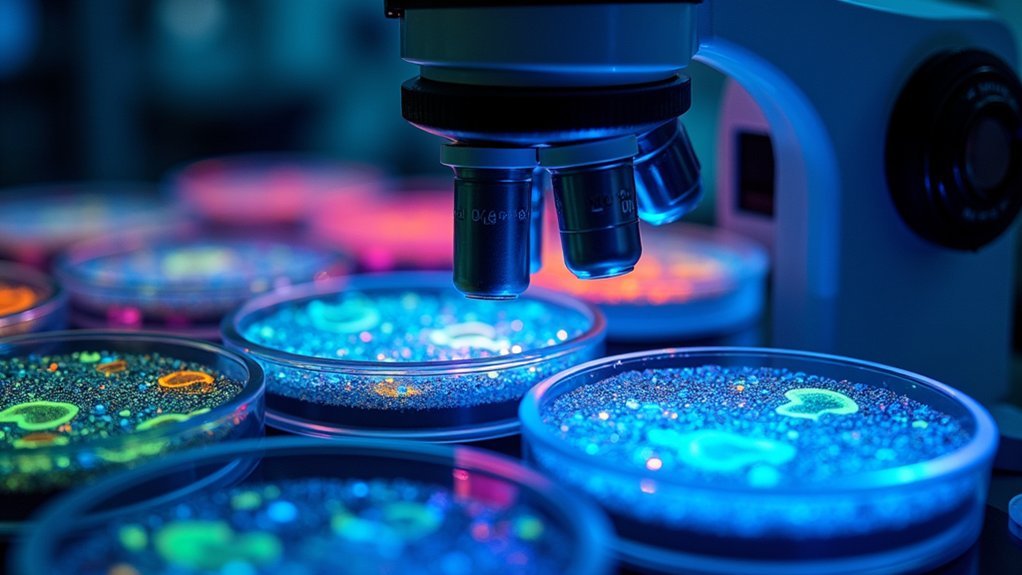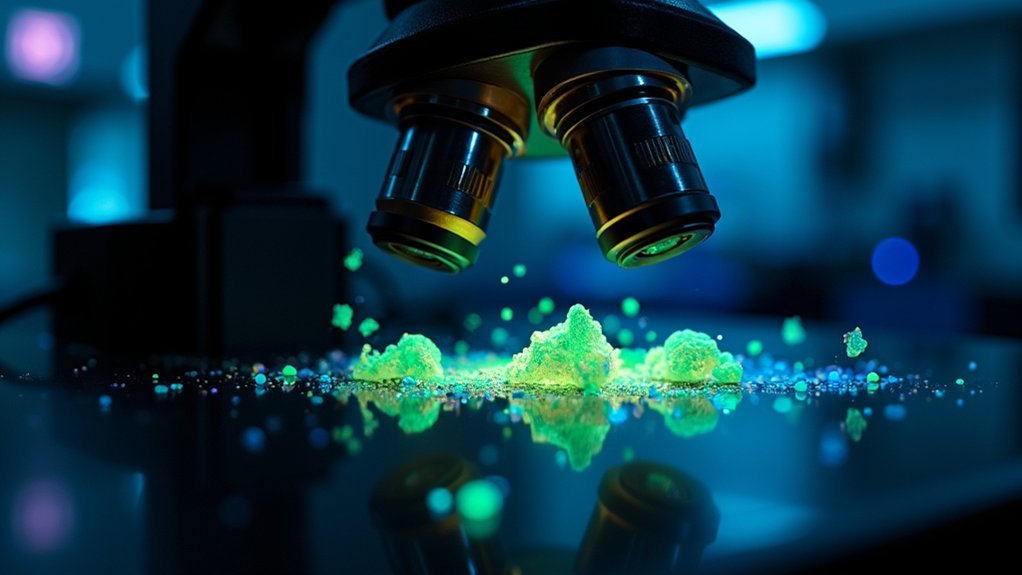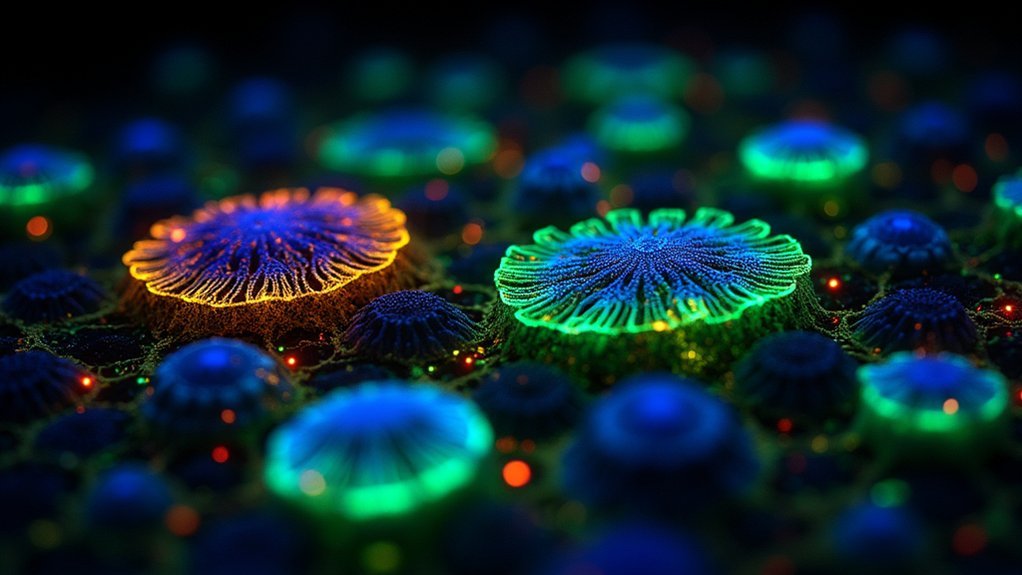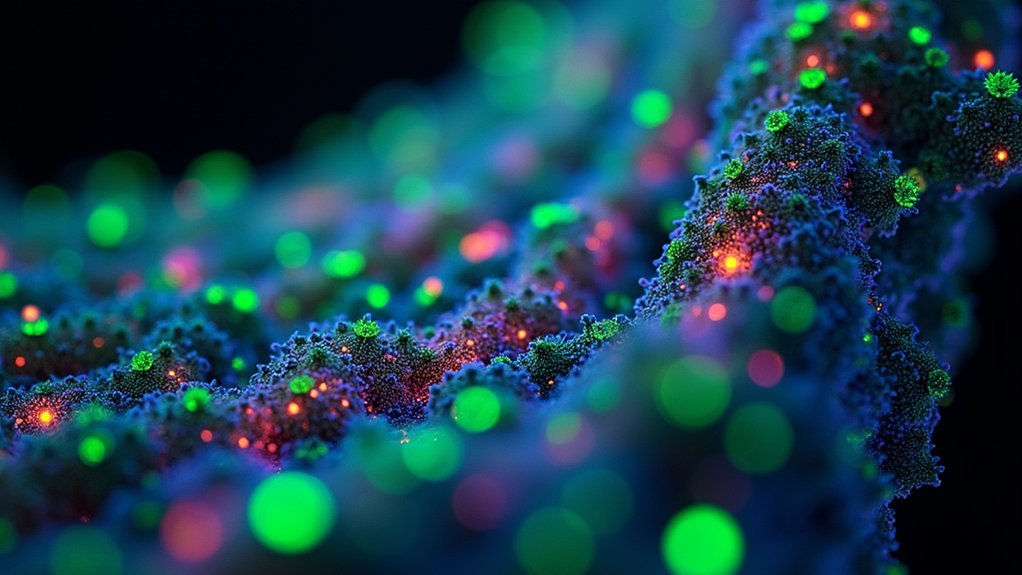To capture time-lapse fluorescent cell images, you’ll need stable fluorescent proteins (like CellLight™ Histone 2B-GFP), proper environmental controls (temperature ±0.1°C, 5% CO₂, humidity), and LED illumination to minimize phototoxicity. Set appropriate time intervals (12-minute intervals work well for most applications) and maximize camera gain while reducing exposure times. Use automated systems like EVOS FL Auto for consistent data collection, and employ specialized software for analysis. The following guide will equip you with essential techniques for capturing stunning cellular dynamics.
Numeric List of 10 Second-Level Headings

When planning your time-lapse fluorescent cell imaging project, you’ll need to follow a structured approach to guarantee high-quality results.
These ten essential components will guide your workflow:
- Selecting Stable Fluorescent Proteins
- Optimizing Cell Culture Conditions
- Setting Up Environmental Controls
- Configuring Your Imaging System
- Determining Appropriate Time Intervals
- Minimizing Phototoxicity
- Establishing Proper Focal Planes
- Programming Automated Image Acquisition
- Managing Data Storage and Organization
- Analyzing Time-Series with Maximum Intensity Projection
Understanding the Fundamentals of Live-Cell Fluorescence Imaging
Live-cell fluorescence imaging success hinges on your careful selection of fluorophores with appropriate brightness, stability, and spectral properties suited to your target structures.
You’ll need to implement phototoxicity mitigation strategies, including minimizing light exposure, using LED illumination, and employing antioxidants to protect cellular viability during extended imaging sessions.
Your optical system should feature high-sensitivity cameras, appropriate filter sets, and objectives with adequate numerical aperture to capture clear images while maintaining cell health throughout time-lapse experiments.
Fluorophore Selection Criteria
Choosing the right fluorophores stands as perhaps the most critical decision you’ll make when planning time-lapse fluorescence imaging experiments. Select fluorescent reagents with high brightness and stability to guarantee reliable signal detection throughout your imaging session while minimizing cell damage from excessive illumination.
Consider the spectral properties of your fluorophores carefully. They must match your imaging system’s light source capabilities—whether LED or laser-based—and have excitation/emission profiles that prevent unwanted overlap. This compatibility reduces background noise and improves image clarity.
Always evaluate cytotoxicity before committing to a fluorophore. Even brilliant labels become problematic if they compromise cellular function.
Prioritize photostable options that resist bleaching during extended imaging periods, as maintaining consistent signal intensity is essential for quantitative analysis of cellular dynamics over time.
Phototoxicity Mitigation Strategies
Phototoxicity represents the central challenge in time-lapse fluorescence microscopy. When light interacts with live cells during imaging, it can damage cellular components and compromise experimental integrity.
To minimize these effects, switch to LED-based illumination systems that reduce harmful UV exposure while maintaining image quality.
Remember to limit your sampling frequency and number of channels to only what’s essential for your experiment. An onstage incubator will help maintain ideal temperature and CO2 levels during extended imaging sessions, further supporting cell viability.
Maximize your camera’s gain settings and utilize low photobleach modes when available. These adjustments allow you to capture high-quality images while greatly reducing light exposure.
Optical System Requirements
While setting up time-lapse fluorescence imaging, your optical system serves as the foundation for experimental success. High-sensitivity optical systems are vital for detecting faint fluorescent signals while maintaining resolution. For live-cell experiments, opt for LED-based illumination to minimize phototoxicity during extended imaging sessions.
| Component | Function | Importance |
|---|---|---|
| High-sensitivity camera | Captures faint signals | Essential for detecting subtle fluorescence |
| LED illumination | Reduces UV exposure | Minimizes phototoxicity and preserves viability |
| Onstage incubator | Controls environment | Maintains ideal temperature, humidity, and gases |
| Autofocus mechanism | Maintains image clarity | Reduces unnecessary light exposure |
| Fluorescence filters | Isolates specific signals | Enhances signal-to-noise ratio |
When configuring your fluorescence microscopy setup, judiciously use autofocus mechanisms and consider systems like the EVOS® FL Auto, which combines advanced optical capabilities with user-friendly interfaces for ideal cellular dynamics studies.
Essential Equipment and Setup Requirements
Successful time-lapse fluorescent cell imaging relies on three critical components working in harmony.
First, you’ll need the EVOS® FL Auto Imaging System, which delivers high-resolution time-lapse images while automating the capture process. This reduces manual intervention that might disrupt your experiment.
Second, environmental stability is non-negotiable. The EVOS® Onstage Incubator maintains precise temperature control (±0.1°C), humidity, and gas concentrations that keep your cells healthy throughout extended imaging sessions.
Finally, your setup requires appropriate fluorescent labeling reagents like CellLight™ Histone 2B-GFP and Mitochondria-RFP for structure visualization. Complement these with LED-based illumination to minimize phototoxicity and photobleaching.
When configuring your system, set specific time intervals between captures and utilize the automated X-Y stage for consistent positioning and focus.
Cell Preparation and Fluorescent Labeling Techniques

Before capturing meaningful time-lapse fluorescent images, you’ll need to properly prepare and label your cells. For HeLa cells, transduce them overnight using CellLight™ Histone 2B-GFP and CellLight™ Mitochondria-RFP to visualize nuclei and mitochondria respectively. These fluorescent labels allow you to clearly differentiate cellular components during imaging.
After labeling, wash your cells with DPBS to remove unbound fluorescent reagents that could create background noise. Transfer the cells to fresh medium to maintain ideal growth conditions throughout imaging.
When you’re ready to image, use a 20x objective on your EVOS FL Auto Imaging System for enhanced resolution of cellular structures. Set the time-lapse function to capture images every 12 minutes to effectively monitor cell division and dynamic processes over extended periods.
Optimizing Environmental Controls for Cell Viability
Maintaining ideal environmental conditions during time-lapse imaging is essential for collecting reliable data while preserving cell health.
You’ll need to implement precise temperature control systems (±0.1°C) to prevent thermal drift, combine humidity management with proper gas regulation to maintain physiological pH, and consider using stage-top incubators with automated X-Y stages for consistent microenvironmental conditions.
These controls work together to minimize stress on your mammalian cells, ensuring they behave naturally throughout extended imaging sessions lasting hours or even days.
Temperature Stability Systems
When capturing time-lapse fluorescent cell images, the stability of your experimental environment directly impacts both image quality and biological relevance.
Stage-top live-cell chambers like the EVOS® Onstage Incubator provide the precise temperature control (±0.1°C) you’ll need for extended imaging sessions.
These temperature stability systems offer several advantages:
- Minimize thermal contractions and expansions, ensuring focus stability throughout your experiment
- Support various culture vessels for convenient time-lapse imaging
- Integrate environmental settings with automated image acquisition
- Maintain stable atmospheric conditions critical for sensitive mammalian cells
Don’t overlook solutions like Live Cell Imaging Solution (LCIS) when using carbonate-buffered media.
These products help sustain physiological pH levels when your cells are outside their standard incubator environment, further enhancing the quality of your live-cell imaging data.
Humidity Control Methods
Proper humidity control stands as a cornerstone of successful time-lapse fluorescent imaging, as even minor fluctuations can trigger rapid evaporation from culture media.
You’ll need to implement reliable humidity control systems to prevent cellular dehydration, which can severely compromise your experimental data.
Stage-top chambers like the EVOS® Onstage Incubator provide precise regulation of moisture levels during extended live-cell imaging sessions.
These systems create stable microenvironments that closely mimic physiological conditions, preserving cell viability throughout your observations.
Additionally, maintaining ideal humidity stabilizes carbonate-buffered media pH, which often fluctuates when cells are removed from standard incubators.
For sensitive mammalian cells, continuous monitoring and adjustment of humidity levels aren’t optional—they’re essential for collecting reliable time-lapse fluorescence data that accurately represents cellular behavior under physiological conditions.
CO₂ Regulation Techniques
Precise CO₂ balance forms the foundation of successful time-lapse fluorescence imaging, with mammalian cells requiring approximately 5% CO₂ concentration to maintain proper pH in culture media.
When implementing CO₂ regulation for live-cell imaging, you’ll need reliable systems that maintain stable environmental conditions.
- Use stage-top chambers like the EVOS® Onstage Incubator to achieve continuous CO₂ control during extended imaging sessions.
- Implement automated systems that integrate CO₂ regulation with temperature and humidity controls for improved cell viability.
- Monitor CO₂ levels regularly to prevent fluctuations that can induce physiological stress in your samples.
- Consider buffering solutions like LCIS for shorter experiments (up to 4 hours) when dedicated CO₂ chambers aren’t available.
Maintaining ideal CO₂ conditions throughout your experiment will greatly enhance data quality and guarantee physiologically relevant results.
Mitigating Phototoxicity and Photobleaching Challenges
Though essential for visualization, fluorescence microscopy presents two significant challenges that can compromise your time-lapse imaging: phototoxicity and photobleaching. When cells are exposed to excessive light during time-lapse experiments, they can become damaged, affecting their viability and potentially skewing your results.
To minimize phototoxicity, reduce your sampling frequency to only what’s necessary for your experimental endpoints. LED-based illumination systems offer a gentler alternative to traditional light sources, decreasing UV exposure that contributes to photobleaching of your fluorophores. Limit your imaging to only essential channels, as each additional wavelength increases the cumulative light exposure.
Whenever possible, use an onstage incubator to maintain ideal temperature and CO₂ levels, ensuring cells remain healthy throughout extended imaging sessions despite the stress of illumination.
Configuring Time-Lapse Parameters for Optimal Results

Successful time-lapse fluorescence imaging hinges on carefully calibrated acquisition parameters that balance data quality with cell viability. Tailor your imaging interval to the cellular process you’re observing—for cell division, capturing frames every 12 minutes often provides sufficient temporal resolution while minimizing light exposure.
For consistent results during extended time-lapse imaging sessions:
- Employ an onstage incubator like the EVOS® system to maintain stable temperature and CO2 levels.
- Configure your system to minimize light exposure by adjusting excitation shutters between captures.
- Maximize camera gain while reducing exposure times to optimize signal-to-noise ratios.
- Utilize a high-resolution cooled CCD camera for clearer images with reduced noise.
These adjustments guarantee you’ll capture meaningful cellular dynamics while preserving sample integrity throughout your experiment.
Advanced Focusing Strategies for Long-Duration Imaging
Maintaining crisp focus throughout extended fluorescence imaging presents one of the greatest challenges for researchers capturing cellular dynamics. To overcome this obstacle, establish focus beacons on specific fields within your wells to minimize focus drift during time-lapse experiments. Rather than relying on continuous autofocus, which increases phototoxicity through excess light exposure, selectively apply autofocus only at predetermined intervals and locations.
When imaging live cells over extended periods, pair your focusing strategy with an onstage incubator like the EVOS® system. This combination guarantees stable temperature and atmospheric conditions while maintaining optical clarity.
For capturing faint signals, leverage high-sensitivity systems such as the BZ-X800, which allow you to increase camera gain instead of light intensity. This approach reduces photobleaching and maintains cell viability while preserving image quality throughout your experimental timeline.
Data Management and Processing of Time-Series Images

Once you’ve established reliable focusing techniques, your next challenge becomes handling the massive datasets generated during time-lapse fluorescence imaging. Effective data management of time-lapse images requires thoughtful organization and processing approaches to extract meaningful biological insights.
For ideal time-series data handling:
- Group images by metadata to maintain consistency across all time points, enabling accurate cell tracking.
- Create image stacks from individual captures taken at defined intervals to streamline analysis.
- Use specialized software like CellProfiler for automated cell identification and tracking across multiple frames.
- Implement Maximum Intensity Projection (MIP) to visualize fluorescence changes in static cells.
Proper management of image formats and settings in your analysis software’s NamesAndTypes module will greatly improve your workflow efficiency when processing large time-lapse datasets.
Analyzing Cellular Dynamics From Time-Lapse Sequences
Tracking cell migration patterns lets you quantify movement speeds and directional persistence, revealing essential insights about cellular responses to environmental cues.
You can measure protein expression kinetics by analyzing fluorescence intensity changes over time, which provides valuable data on gene regulation and protein turnover rates.
Division rates can be precisely quantified by counting mitotic events within your time-lapse sequences, helping you assess proliferation dynamics and cellular responses to experimental treatments.
Cell Migration Tracking
After collecting your time-lapse fluorescent images, you’ll need to analyze the cellular dynamics to extract meaningful migration data.
Cell migration tracking provides essential insights into how cells move, interact, and respond to their environment.
To effectively track cell migration in your time-lapse sequences:
- Use fluorescent nuclear markers like CellLight Histone 2B-GFP to distinctly identify individual cells throughout the imaging period.
- Maintain consistent 12-minute intervals between image captures to guarantee smooth tracking of continuous cell movement.
- Leverage the EVOS Onstage Incubator to control temperature and CO2 levels, preserving natural migration behaviors.
- Apply tracking software to quantify migration parameters including speed, directionality, and distance traveled.
This analytical approach transforms your raw time-lapse images into quantifiable data about cell migration patterns, enabling you to draw meaningful conclusions about cellular behavior under specific conditions.
Protein Expression Kinetics
Analyzing protein expression kinetics provides deeper insights into cellular functions than static measurements alone. Time-lapse imaging lets you monitor how protein levels change in real-time, revealing dynamic patterns invisible in single timepoint snapshots.
For ideal results, use stable fluorophores like CellLight Histone 2B-GFP and Mitochondria-RFP to clearly visualize cellular structures during processes like cell division. Maintain consistent environmental conditions (temperature, CO2) to guarantee cells behave naturally throughout your observation period.
Automated systems like EVOS FL Auto enable consistent data collection across multiple timepoints without manual intervention.
After capturing your sequences, streamline analysis with specialized software such as CellProfiler or Fiji to quantify protein expression changes objectively. These tools can track fluctuations in fluorescence intensity that correspond directly to changes in protein abundance or localization.
Quantifying Division Rates
Beyond protein expression patterns, time-lapse fluorescence imaging reveals cellular proliferation dynamics with remarkable precision. To accurately quantify division rates, you’ll need to track cells through complete cycle phases using fluorescent markers like Histone 2B-GFP, which clearly highlights chromosomal behavior during mitotic events.
- Set your EVOS FL Auto Imaging System to capture images at consistent intervals, ensuring you don’t miss critical division moments.
- Measure the duration between successive divisions by tracking individual cells throughout your time-lapse sequence.
- Analyze mitotic phase timing (prophase, metaphase, anaphase, telophase) to identify potential division anomalies.
- Use CellProfiler for automated tracking and quantification of fluorescence intensity changes that indicate division events.
This approach provides thorough documentation of division rates, allowing you to detect subtle changes in proliferation patterns across experimental conditions.
Frequently Asked Questions
Can I Use Fixed Cells Instead of Live Cells?
Yes, you can use fixed cells instead of live cells. They won’t show dynamic processes over time, but they’re perfect when you’re interested in capturing a specific cellular state or structure.
How Do I Troubleshoot Uneven Illumination Across My Field of View?
You’ll need to check your light source alignment, use flat-field correction, clean your optical components, and adjust your microscope’s Köhler illumination. A uniform fluorescent sample can help calibrate your system too.
Is It Possible to Capture Multiple Cell Lines Simultaneously?
Yes, you can capture multiple cell lines simultaneously using multicolor fluorescent labeling with distinct markers for each line. Consider using multi-well chambers or microfluidic devices with appropriate filter sets to distinguish them.
What Software Integrations Work Best for Automated Cell Tracking?
For automated cell tracking, you’ll find CellProfiler, TrackMate (ImageJ plugin), and Imaris work best. They integrate with MATLAB and Python, offering powerful algorithms that’ll handle multiple cell lines simultaneously with minimal manual correction.
How Frequently Should I Calibrate the Microscope Between Experiments?
You should calibrate your microscope at least monthly, but also after any hardware adjustments, when changing objectives, or if you notice image quality deterioration. Weekly calibration is ideal for high-precision tracking experiments.
In Summary
You’ve now mastered time-lapse fluorescent imaging from setup to analysis. Remember that balancing image quality with cell viability is essential for meaningful results. As you refine your technique, you’ll capture increasingly valuable data on cellular dynamics. Don’t hesitate to adapt these methods to your specific research needs—the most successful imaging protocols are those you’ve customized to your unique biological questions.





Leave a Reply